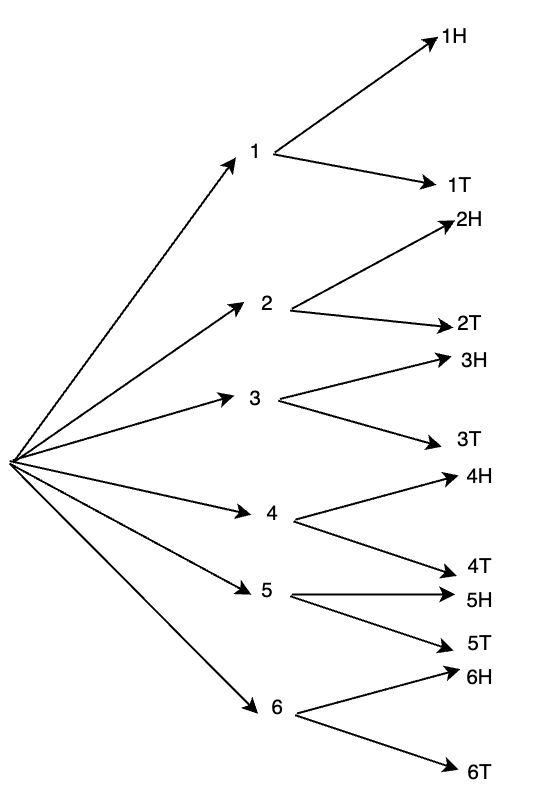随机实验——概率
在板球比赛中,比赛开始前。两个船长去折腾。掷硬币是一种掷硬币并检查结果是“正面”还是“反面”的活动。同样,掷骰子给我们一个从 1 到 6 的数字。所有这些活动都是实验的例子。给我们一个结果的活动称为实验。一个实验可以有不止一个结果。概率领域更关注随机实验。这些实验没有确定的结果,即您无法绝对确定地预测这些实验的结果。
实验
概率论是基于实验的。实验是为了发现未知事物、测试原理或假设等目的而进行的测试、试验或程序。以下是可以被视为实验的一些活动的列表:
- 反复掷硬币并记下结果。有两种可能的结果——正面(H)或反面(T)。
- 投掷一个公平的骰子并观察它给出的数字。
- 从德里开车到班加罗尔,测量两个城市之间的距离。
上面列出的所有活动都可以描述为实验。请注意,在活动 1 和活动 2 中,我们不知道活动的结果,也不能肯定地说骰子上会出现什么数字,或者我们是否会在抛硬币时得到正面或反面。活动 3 的结果可以很容易地预测。这意味着在实验 1 和 2 中存在随机性。这样的实验称为随机实验。
随机实验
概率论的基本假设是实验必须是随机的。假设实验可以在相同条件下进行无限多次。这个假设变得很重要,因为经典概率论和基于频率的概率论在寻找实验中的长期行为时都依赖于这个假设。
A random experiment is defined as an experiment whose outcome cannot be predicted with certainty.
掷骰子时无法预测结果。这是一个随机实验的例子。每个随机实验必须满足以下两个条件:
- 该实验可以在相同条件下重复多次。
- 实验的结果无法事先肯定地预测。
为了说明这个概念,我们以这个实验为例。
投掷硬币两次并记录结果。可能的结果是:
HH、HT、TH、TT
下图以树的形式表示结果。

请注意,此实验中有四种可能的结果,并且无法事先预测它们。所有可能结果的集合构成了随机实验的样本空间。因此,在我们的实验中,样本空间是一个通用集。记为 S。对于上述实验,
S = {HT, HH, TH, TT}
当一个实验重复多次时,每一次都称为一次试验。因此,试验可以描述为随机实验的特定表现。在这个特定的实验中,试验是抛硬币。两个这样的试验构成了整个实验。
事件和概率
对于样本空间 S 的实验,目标是为某些结果分配概率。为了理解事件的概念,让我们再次考虑一个实验。掷了两个骰子,我们对骰子数量之和等于 6 的结果感兴趣。第一步是考虑这个实验的样本空间。
S = {(1,1); (1,2); …..(1, 6);
(2,1); (2,2); ……(2,6);
(3,1); (3,2); ….(3,6);
(4,1); (4,2); …..(4,6);
(5,1); (5,2); ……(5,6);
(6,1); (6,2); ……(6,6); }
这些都是这个实验的所有可能结果。
An event is the subset of the sample space.
在这种情况下,事件将是骰子上的数字之和等于 6 的结果。它将包含集合 S 中的所有结果,其中数字之和为 6。假设事件被表示再见,
E = {(2,4); (4,2); (3,3); (3,3); (1,5); (5,1)}
这个集合的基数|E| = 6 而样本空间的基数 |S| = 36。
Probability is defined as the ratio of the favorable number of outcomes and total number of possible outcomes
P(Event) = ![]()
对于这种情况,
P(E) = ![]()
⇒ P(E) =
⇒ P(E) =
⇒ P(E) = ![]()
让我们看一些关于这些概念的例子。
示例问题
问题 1:写出投掷 3 次硬币的样本空间。
回答:
A coin toss gives either Head (H) or Tails(T).
Outcome of three coin tosses will be triplets of Heads and Tails.
S = {HHH, HHT, HTH, HTT, THH, THT, TTH, TTT}

问题 2:在下列活动中。选择随机活动:
- 从装有黑白球的瓮中抽出一个球。
- 在计算器上乘以 4 和 8。
- 一个人的诞生
回答:
Each random experiment/activity must fulfill the following two conditions:
- The experiment can be repeated a number of times under the same conditions.
- The outcome of the experiment cannot be predicted beforehand with certainty.
Drawing a ball from an urn containing black and white balls.
This can be repeated as many times as required, and also it cannot be predicted which ball will be drawn. Thus is a random activity.
Multiplying 4 and 8 on the calculator.
This activity can be repeated a number of times, but the result of this activity can be predicted beforehand. Thus, it is not a random activity.
Birth of a person
Birth of a person cannot be repeated. So, it is not a random activity.
问题 3:考虑一个掷骰子然后抛硬币的实验。绘制样本空间。
回答:
A die when rolled given {1, 2, 3, 4, 5, 6} as result while a coin toss gives {H, T}.

Sample space S = {(1, H); (2, H); (3, H); (4,H); (5,H); (6,H); (1, T); (2, T); (3, T); (4, T); (5, T); (6, T)}
问题 4:求在 3 次抛硬币中出现 2 个正面的概率。
回答:
A coin toss gives either Head (H) or Tails(T).
Outcome of three coin tosses will be triplets of Heads and Tails. So, the sample space is,
S = {HHH, HHT, HTH, HTT, THH, THT, TTH, TTT}
Counting the number of favorable outcomes, there are three outcomes with two heads.
Probability = ![]()
P = ![]()
问题 5:找出从洗好的一副牌中抽出 A 的概率。
回答:
A deck of cards contains 52 cards and out of which 4 are aces. The formula for probability,
Probability = ![]()
Favorable Number of Outcomes = 4
Total Number of Outcomes = 52
Probability = ![]()
⇒ P = ![]()
⇒ P = ![]()
问题 6:找出在 3 次抛硬币中至少得到 1 个正面的概率。
回答:
A coin toss gives either Head (H) or Tails(T).
Outcome of three coin tosses will be triplets of Heads and Tails. So, the sample space is,
S = {HHH, HHT, HTH, HTT, THH, THT, TTH, TTT}
Counting the number of favorable outcomes, there are seven outcomes with atleast one head.
Probability = ![]()
P = ![]()